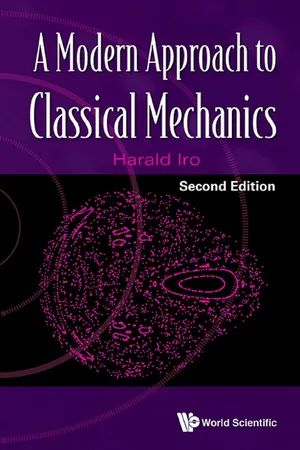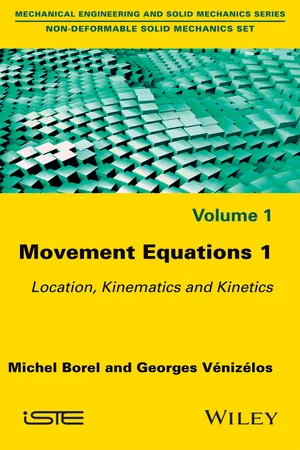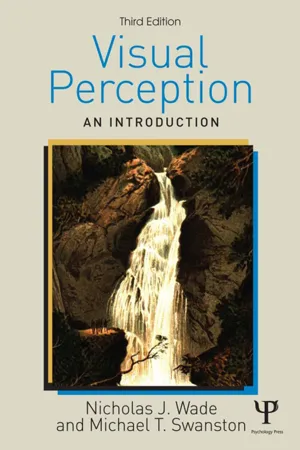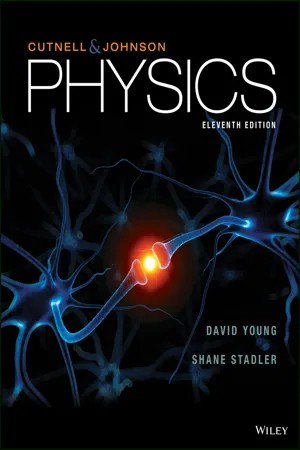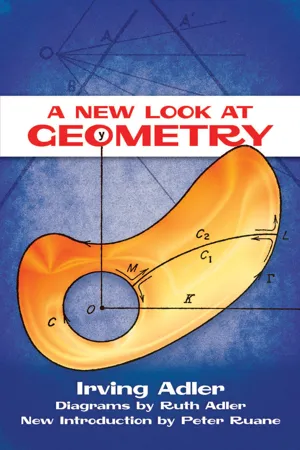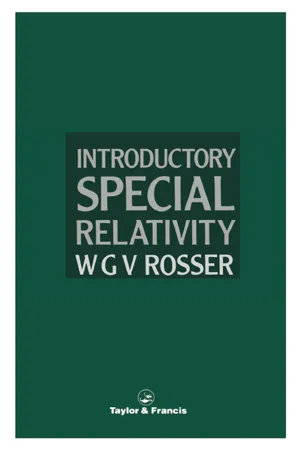Physics
Frame of Reference
A frame of reference in physics is a coordinate system used to describe the position, orientation, and motion of objects. It provides a point of view from which measurements and observations are made. Different frames of reference can yield different descriptions of the same event, highlighting the importance of choosing an appropriate frame for analyzing physical phenomena.
Written by Perlego with AI-assistance
Related key terms
Related key terms
1 of 4
Related key terms
1 of 3
6 Key excerpts on "Frame of Reference"
- eBook - ePub
- Harald Iro(Author)
- 2015(Publication Date)
- WSPC(Publisher)
Conceptually, a Frame of Reference comprises of a point of reference 1, together with devices for determining the position of some event with respect to the point of reference, and appropriately installed clocks for determining the time of occurrence of the event at any position 2. The mathematical counterpart of such a reference frame is a coordinate system (origin and axes) and a time scale, which together allow us to describe, for example, the motion of a particle at any time – its position r at time t, as well as its rate of change with time by and. In any particular reference frame, different coordinate systems may be chosen (e.g. Cartesian or spherical coordinates). When relating the observations of physical quantities in two different frames of reference, one has to state how to compare them: what do the views in the two systems have in common? A fundamental assumption of nonrelativistic, classical physics enters here: that the distance between two physically distinguished positions – e.g. between two bodies – is independent of the reference frame 3. However, changing the reference frame may also affect physical quantities, as in the example of particle collision the scattering angle or the velocity observed in the center of mass frame and in the laboratory frame. A change of coordinate system within a given frame, has, of course, no influence on the physical processes; only the (mathematical) description is affected by the choice 4. The coordinate system is often considered to be the reference frame, but strictly speaking one should distinguish between these two notions. Of course, a change of reference frame is accompanied by a coordinate transformation (but not, in general, vice versa) - eBook - ePub
Movement Equations 1
Location, Kinematics and Kinetics
- Michel Borel, Georges Vénizélos(Authors)
- 2016(Publication Date)
- Wiley-ISTE(Publisher)
1.2. Frame of Reference1.2.1. Setting up a Frame of Reference
When a system of reference is used for the study of a motion, it is also called a Frame of Reference. This notion is of particular importance in the study of motion, since its choice depends on:- – the observer, meaning the context in which the motion evolves;
- – the forces that act on the mechanical system under study, as the set of these forces should be inside the environment of reference, in order to be able to apply to this motion the principles that govern it.
1.2.1.1. Choosing the elements of a Frame of Reference
In principle, the Frame of Reference used to locate a solid body and follow its evolution should consist of elements that are independant of the body and of the motion to be described. When the latter takes place in the terrestrial environment, the ideal Frame of Reference meets the following conditions:- – the point of reference chosen as origin of the system of reference is the center of inertia of the solar system.
- – its independent directions are symbolized by three axes that are defined by three stars considered to be fixed relative to the motion of the Earth.
It is the solar Frame of Reference, noted ‹g›, which ultimately illustrates the fundamental notion of the Galilean system of reference, which will be specified later on in this chapter.This Frame of Reference is, however, poorly suited for the vast majority of motions taking place in the terrestrial environment, if only because of the measurement of the distance “origin-element”, which fixes a scale that is completely disproportionate relative to the dimensions of the body whose motion is studied or to its field of evolution.Moreover, since the Earth is moving relative to this system of reference, its axes, which would provide three independent directions, cannot be considered fixed for the motion studied. If we resorted to such a Frame of Reference, we would constantly be in relative motion, which would further complicate the formulation of the problem even though, for most of the motions studied in the terrestrial space, the drive terms are negligible compared with the relative - eBook - ePub
Visual Perception
An Introduction, 3rd Edition
- Nicholas Wade, Mike Swanston(Authors)
- 2013(Publication Date)
- Psychology Press(Publisher)
Our language is replete with terms relating to where things are with respect to one another. For example, is this book on the table or beneath the light or beside the window or above the floor? All these questions refer to relations between objects. In these statements there is an implicit assumption of the greater stability of one of the objects (table, light, window, floor) relative to the book. Some objects may be considered to be more stable than others, but those objects could be changing place, too. If the book is being read on a train then all the objects would be moving in the same direction. The statements above would still apply if the carriage was taken as a Frame of Reference, but the carriage (and its contents) could be located with respect to a larger Frame of Reference, like the surface of the earth.A physicist would describe the locations of objects in this way, and also draw attention to the fact that the earth is moving relative to the sun, which is not, of course, stationary with respect to the centre of the Milky Way and so on. A physicist assumes that these nested frames of reference can be defined in abstract terms; the descriptions do not make any reference to the location of an observer. In our example, the reader of the book can change location with respect both to it and to other frames of reference like the floor. Physicists relate objects in the world to other objects; they are not (as physicists) a part of that world themselves. If we are to discuss perceived location then we must also take the perceiver into account. Thus the situation is somewhat different, and more complex, for perception than for physics. In practice, there is a point at which the Frame of Reference is sufficiently broad to encompass perception and action. This is typically the surface of the earth, which is perceived to be stationary.As we shall see, under certain conditions this assumption can lead to errors in perception of self location.Figure 6.1 The layout of a chessboard with symbols for rows and columns, so that every square can be specified.The concept of frames of reference is, accordingly, of critical importance in understanding the issues in this and subsequent chapters. By way of analogy, Locke’s chessboard could be likened to the retina, and the location of a piece could correspond to a particular point on the retina. If the chessboard (or retina) is adopted as a Frame of Reference then the location of a piece with respect to it would be called, in our terminology, retinocentric . All that is required to specify a particular square is the adoption of a point on the surface as the origin with specified units of separation. On a chessboard (Figure 6.1 ) the convention is to adopt the black square with the White Queen’s Castle as row a column 1 (a1 ) and then the rest of the 64 squares can be given specific locations (like b6 - eBook - ePub
- John D. Cutnell, Kenneth W. Johnson, David Young, Shane Stadler(Authors)
- 2018(Publication Date)
- Wiley(Publisher)
Each observer is at rest relative to his own reference frame. However, the earth-based observer and the airborne observer are moving relative to each other and so, also, are their respective reference frames. FIGURE 28.1 Using an earth-based reference frame, an observer standing on the earth records the location and time of an event (the space shuttle lift-off). Likewise, an observer in the airplane uses a plane-based reference frame to describe the event. The theory of special relativity deals with a “special” kind of reference frame, called an inertial reference frame. As Section 4.2 discusses, an inertial reference frame is one in which Newton's law of inertia is valid. That is, if the net force acting on a body is zero, the body either remains at rest or moves at a constant velocity. In other words, the acceleration of such a body is zero when measured in an inertial reference frame. Rotating and otherwise accelerating reference frames are not inertial reference frames. The earth-based reference frame in Figure 28.1 is not quite an inertial frame because it is subjected to centripetal accelerations as the earth spins on its axis and revolves around the sun. In most situations, however, the effects of these accelerations are small, and we can neglect them. To the extent that the earth-based reference frame is an inertial frame, so is the plane-based reference frame, because the plane moves at a constant velocity relative to the earth - eBook - ePub
- Irving Adler, Ruth Adler, Peter Ruane(Authors)
- 2013(Publication Date)
- Dover Publications(Publisher)
Consequently, in Newtonian physics, the length of a directed segment is an absolute measure that is independent of the choice of axes by the observer. If there are many observers, each equipped with his own Frame of Reference, then while each may observe different x and y components for the directed segment AB, depending on the orientation of his axes, all will compute the same length for the segment. Inertial Frames of Reference In the preceding paragraph we dealt with measurements made at a fixed instant of time, so that it might be assumed that the frames of reference were stationary in absolute space. However, as soon as we begin to observe events that occur as time passes, we are not free to make this assumption any more, because it is possible that the Frame of Reference of an observer may be moving through absolute space. Among all possible frames of reference, there are some that have the special property that observations made from them are subject to Newton’s First Law of Motion, which says, “Every body continues in its state of rest, or of uniform motion in a straight line, unless it is compelled to change that state by forces impressed on it.” Frames of reference that have this property are called inertial frames. Newton assumed that frames of reference that are stationary in absolute space are inertial. It follows from this assumption that any Frame of Reference that has a uniform speed through absolute space is also inertial. Conversely, any Frame of Reference that is inertial has a uniform speed through absolute space, and in the special case where the speed is zero, the frame is at rest in absolute space. The Frame of Reference usually used for the observation of events in a laboratory is the ground on which we stand. For small intervals of time, during which the effects of the earth’s rotation are negligible, the ground as a Frame of Reference is approximately inertial - eBook - ePub
- W G V Rosser(Author)
- 2017(Publication Date)
- CRC Press(Publisher)
If in a reference frame a particle under the influence of no forces (e.g. a particle far away from any other particles capable of exerting forces) travels in a straight line with constant speed then Newton’s first law (the principle of inertia) is valid in that frame, which is then considered suitable for the application of Newton’s laws of motion. Such a reference frame is called an inertial reference frame, or inertial frame or sometimes a Galilean reference frame. An experimenter at rest in an inertial reference frame is called an inertial observer. The same definition of an inertial reference frame will be used in the theory of special relativity. Owing to the rotation of the Earth, the laboratory frame, that is a reference frame fixed to the Earth, is strictly not an inertial reference frame, and effects associated with the Earth’s rotation are sometimes important. For example, consider a spaceship coasting with uniform velocity relative to the fixed stars. There are no applied forces acting on the spaceship. If its position is plotted on a coordinate system fixed to the Earth then, owing to the Earth’s rotation, the spaceship will appear to travel in a spiral path, going around through 360° every day. According to Newton’s first law, since there are no forces acting on the spaceship, it should travel in a straight line in all inertial reference frames. This shows that the laboratory frame, i.e. a reference frame fixed to the Earth, is not an inertial reference frame, and effects associated with the Earth’s rotation are sometimes important even in terrestrial experiments, such as long-range naval gunnery and Foucault’s pendulum experiment. In these cases we get a better approximation to an inertial reference frame by taking a frame at rest relative to the solar system or the fixed stars
Index pages curate the most relevant extracts from our library of academic textbooks. They’ve been created using an in-house natural language model (NLM), each adding context and meaning to key research topics.
Explore more topic indexes
Explore more topic indexes
1 of 6
Explore more topic indexes
1 of 4
